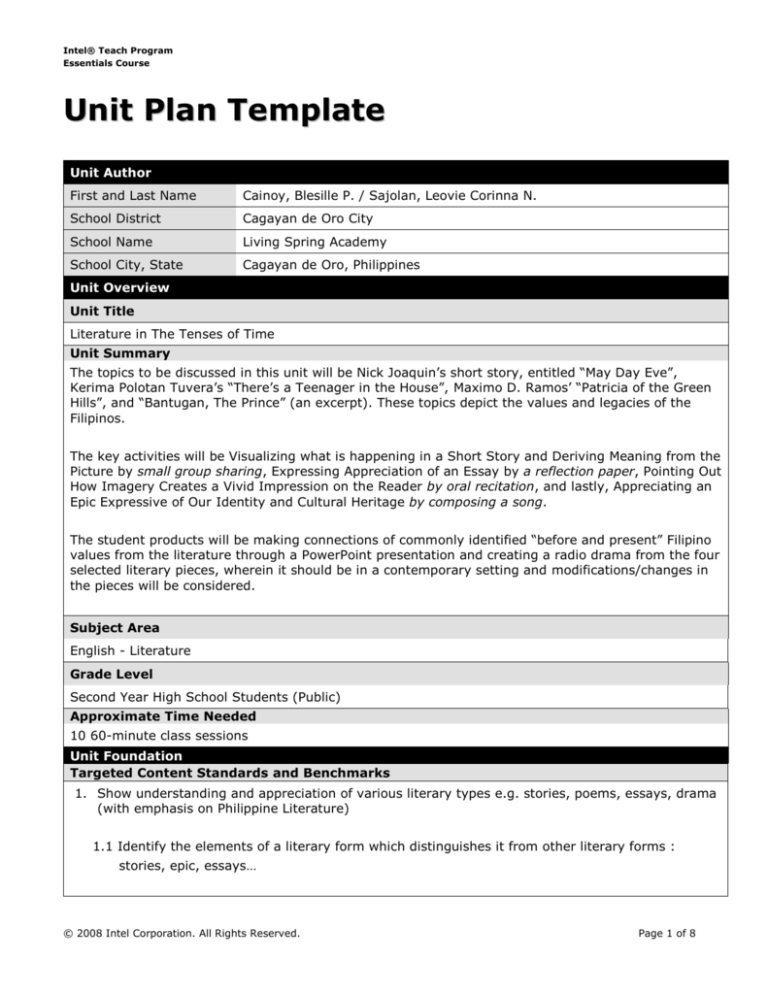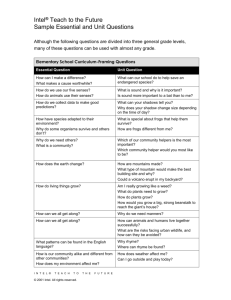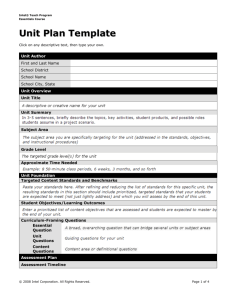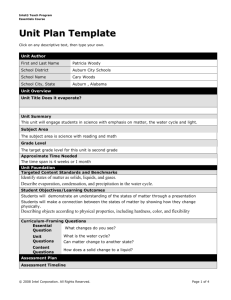
Intel® Teach Program
Essentials Course
Unit Plan Template
Unit Author
First and Last Name
Cainoy, Blesille P. / Sajolan, Leovie Corinna N.
School District
Cagayan de Oro City
School Name
Living Spring Academy
School City, State
Cagayan de Oro, Philippines
Unit Overview
Unit Title
Literature in The Tenses of Time
Unit Summary
The topics to be discussed in this unit will be Nick Joaquin’s short story, entitled “May Day Eve”,
Kerima Polotan Tuvera’s “There’s a Teenager in the House”, Maximo D. Ramos’ “Patricia of the Green
Hills”, and “Bantugan, The Prince” (an excerpt). These topics depict the values and legacies of the
Filipinos.
The key activities will be Visualizing what is happening in a Short Story and Deriving Meaning from the
Picture by small group sharing, Expressing Appreciation of an Essay by a reflection paper, Pointing Out
How Imagery Creates a Vivid Impression on the Reader by oral recitation, and lastly, Appreciating an
Epic Expressive of Our Identity and Cultural Heritage by composing a song.
The student products will be making connections of commonly identified “before and present” Filipino
values from the literature through a PowerPoint presentation and creating a radio drama from the four
selected literary pieces, wherein it should be in a contemporary setting and modifications/changes in
the pieces will be considered.
Subject Area
English - Literature
Grade Level
Second Year High School Students (Public)
Approximate Time Needed
10 60-minute class sessions
Unit Foundation
Targeted Content Standards and Benchmarks
1. Show understanding and appreciation of various literary types e.g. stories, poems, essays, drama
(with emphasis on Philippine Literature)
1.1 Identify the elements of a literary form which distinguishes it from other literary forms :
stories, epic, essays…
© 2008 Intel Corporation. All Rights Reserved.
Page 1 of 8
Intel® Teach Program
Essentials Course
2. Discover literature as an art form serving as a means of developing better understanding of the
human condition and the environment
2.1 Express appreciation of one’s identity and cultural heritage
2.1.1 Show appreciation for worthwhile local traditions and practices expressed in Philippine
literature and the values they represent
2.1. 2 Express appreciation of literature expressive of the Filipino identity
Student Objectives/Learning Outcomes
At the end of the unit, the Second Year students are expected to:
a. Identify the elements of a literary form which distinguishes it from other literary forms
b. Orally explain their insights (Filipino values) from the short stories through a small group
sharing
c. Write a reflective composition from the essay entitled “There’s A Teenager in the House”
d. Individually articulate the various Imagery found in the short stories
e. Creatively compose a song that depicts the Filipino Identity and Cultural Heritage
f.
Produce a PowerPoint presentation that shows the commonly identified “before and present”
Filipino values from the literature
g. Artistically make a radio drama from the four selected literary pieces
Curriculum-Framing Questions
Essential
Questions
How do Filipino values and traditions influence the students’ attitude toward
learning?
How do Filipino values and traditions build the holistic development of the
students?
1. What are elements of a literary form which distinguishes it from other
literary forms?
Unit
Questions
2. What is the importance of Imagery in literature?
3. Do Filipinos still preserve their cultural identity, heritage and values?
Why?
4. How does literature shape the Filipinos as people?
© 2008 Intel Corporation. All Rights Reserved.
Page 2 of 8
Intel® Teach Program
Essentials Course
From “May Day Eve”
1. What do old people believe about the first of May? What is one supposed
to do in order to know his future spouse?
2. Who is Anastasia and what is her part in the story?
3. Did the girl and the boy of the first generation make a happy marriage?
Give reasons. Cite passages or incidents from the story to prove your
answer.
From “There’s A Teenager in the House”
1. Who is the “I” or the narrator in the selection?
2. What does she observe about her son? How do these observations of the
son’s behavior affect her?
3. What is the mother’s attitude towards her son? Is she indifferent?
Angry? Understanding?
Content
Questions
From “Patricia of the Green Hills”
1. Who is Patricia? Why did the narrator and his wife adopt her?
2. Does the selection bring out positive traits of a Filipino adolescent? If
yes, cite instances in Patricia’s life that bring out the following:
A. Love for family
B. Respect for Others
C. Dependability
D. Gracious manners
3. Is there truism in the saying “Home is where your heart is.” Prove your
answer.
From “Bantugan, The Prince”
1. Who is Bantugan? Describe him from what you gather from the epic.
2. How do his enemies happen to invade his place?
3. Which of Bantugan’s qualities enable him to win? Which of his qualities
do not meet the qualities of a hero?
Assessment Plan
Assessment Timeline
© 2008 Intel Corporation. All Rights Reserved.
Page 3 of 8
Intel® Teach Program
Essentials Course
Before project work begins
Questioning
Brainstorming
Reflection Essay
Students work on projects
and complete tasks
About the Before and Present
Values of Filipinos from Literature
Checklist
Group Consultation
Rubrics for both projects
PowerPoint Presentation
Outline/Flow (Planning)
After project work is
completed
Rubrics for both projects
Showcasing/Culminating
of Projects (PowerPoint
Presentation/Radio
Drama)
Final Processing
Script Draft (Radio
Drama)
Assessment Summary
Before the project begins, the teacher will throw a series of questions to the students with regards to
their understanding about the projects. “Questioning” will be the venue for them to make clarifications
and provide awareness to the teacher about the readiness of the students. “Brainstorming”.
During the project-making, the students need to monitor their own progress by means of a
“Checklist”, which is provided by the teacher. Also, to follow up their works, each group shall meet
with the teacher for a “Consultation”. Moreover, there will be rubrics for both projects that the
students must take into consideration. “Planning” about their video project and radio drama will then
follow. In addition, they have to submit their PowerPoint presentation outline and the script draft of
their radio drama.
After the project has been successfully completed, the students will be tasked to showcase their
projects in class, first will be the “PowerPoint Presentation” and followed by the “Radio Drama”. Each
of the groups will be assessed through the use of Rubrics. Lastly, there will be a “Final Processing”
after presenting the projects.
Unit Details
Prerequisite Skills
The students must have the knowledge already on the different literary genres, specifically on short
stories, essays and epics.
Instructional Procedures
Example Instructional Cycle for May Day Eve by Nick Joaquin
A. Motivation (Preparatory)
© 2008 Intel Corporation. All Rights Reserved.
Page 4 of 8
Intel® Teach Program
Essentials Course
The teacher will give some superstitious beliefs (Ex. During night time, sweeping the floor
is not allowed, for luck will go away.) to the students and she will ask if they practice those
beliefs at home. The students who will raise their hands shall be called and share to the
class about why they have such belief, where did it start and who started it.
B. Lesson Proper (Students’ Activity)
Teaching Strategy: Cooperative Leaning
First, the teacher will group the students into four. She will task each group to read the
short story entitled May Day Eve by Nick Joaquin, for 20 minutes. The groups will be asked
to visualize what happens in the story and to derive meaning from the picture by small
group sharing. The key points that they have gathered from the story will be written in a
manila paper/s, provided by the teacher.
Second, after the small group sharing, there will be a teacher-student interaction,
pertaining to the story literary piece at hand.
C. Application (Project)
The student products will be making connections of commonly identified “before and
present” Filipino values (specifically the superstitious beliefs) from the literature through a
PowerPoint presentation.
Accommodations for Differentiated Instruction
Special Needs
Students
Nonnative
Speakers
These type of students will be given extra time to read the short story and will
be helped by their peers and teacher to have a better and clearer understanding
the piece. With regards to the project, the teacher will make sure that these
students will be evenly distributed to those groups who don’t have special
needs. These students will express their learning through a one-on-one basis of
an oral quiz.
The language support that will be used is English as a Second Language (ESL)
instruction. The nonnative speakers will be provided with various activities,
wherein their English learning can be enhanced. Peer tutoring will be encouraged
as well in order to have a more likable and more comfortable ambiance of
learning.
The instructional materials to be utilized are first-language texts, dual-language
dictionary (ex. English-Filipino, Bisaya-English), translation tools (internet
sources), posters, flip charts, pocket charts and the like.
The students can express their learning by means of using the mother tongue
first, so that it will be easier for them to communicate their ideas. The usage of
English language will be imposed when they are completely ready.
© 2008 Intel Corporation. All Rights Reserved.
Page 5 of 8
Intel® Teach Program
Essentials Course
Gifted/Talented
Students
Discovery Learning will be one of the various ways that this type of students
may explore the lessons. They can exhibit their understanding through creative
writing, in-depth analysis about the story using some literary approaches,
artistic interpretation through painting, drawing, photo essay or collage.
The specific resources to be used are writing and art materials.
Materials and Resources Required For Unit
Technology – Hardware (Click boxes of all equipment needed)
Camera (Documentation)
Laser Disk
VCR
Computer(s)
Printer
Video Camera (Documentation)
Digital Camera
Projection System
Video Conferencing Equip.
DVD Player
Scanner
Other Materials for Radio Drama
Internet Connection
Television
Technology – Software (Click boxes of all software needed.)
Database/Spreadsheet
Image Processing
Web Page Development
Desktop Publishing
Internet Web Browser
Word Processing
E-mail Software
Multimedia
Other
Encyclopedia on CD-ROM
Textbook
o
Printed Materials
Supplies
English Expressways (for Second Year Students) by Virginia F
Bermudez, Ed.D., et al
Curriculum Guides
Reference materials
Pictures of the literary authors and characters, story scenario (ex.
during 1940’s – May Day Eve)
Art and Writing Materials (for Gifted students)
Manila Papers (group sharing)
Markers (broad and fine)
© 2008 Intel Corporation. All Rights Reserved.
Page 6 of 8
Intel® Teach Program
Essentials Course
___________.(2010). Nick Joaquin.
Retrieved September 9, 2010, from http://en.wikipedia.org/wiki/Nick_Joaquin
___________.(2010). Kerima Polotan Tuvera.
Retrieved September 9, 2010, from http://en.wikipedia.org/wiki/Kerima_Polotan_Tuvera
___________.Short Stories: May Day Eve.
Retrieved September 9, 2010, from
www.seasite.niu.edu/Tagalog/Literature/Short%20Stories/May%20Day%20Eve.htm
__________.(2009).Philippine Literature.
Retrieved September 9, 2010, from http://www.camperspoint.com/spip.php?article227
__________.(2010). Philippine Epic Poetry.
Retrieved September 9, 2010,
from http://en.wikipedia.org/wiki/Philippine_epic_poetry#Mindanao_epic_poetry
__________.(2004). 5 Important Elements of a Short Story.
Retrieved September 9, 2010,
from http://users.aber.ac.uk/jpm/ellsa/ellsa_elements.html
Internet Resources
__________.(2010). Imagery (Literature).
Retrieved September 9, 2010,
from http://en.wikipedia.org/wiki/Imagery_%28literature%29
__________. Folk Beliefs: Love, Courtship, and Marriage.
Retrieved September 9, 2010,
fom http://www.seasite.niu.edu/Tagalog/Folk_Beliefs/filipino_folk_beliefs.htm
© 2000-2007 Intel Corporation. All Rights Reserved.
Page 7 of 8
Intel® Teach Program
Essentials Course
Literary Writers
Other students/classrooms
Other Resources
Co-teachers
Community Members
Parents/Siblings
Programs of the Intel® Education Initiative are funded by the Intel Foundation and Intel Corporation.
Copyright © 2007, Intel Corporation. All rights reserved. Intel, the Intel logo, Intel Education Initiative, and Intel Teach Program are
trademarks of Intel Corporation in the U.S. and other countries. *Other names and brands may be claimed as the property of others.
© 2000-2007 Intel Corporation. All Rights Reserved.
Page 8 of 8








